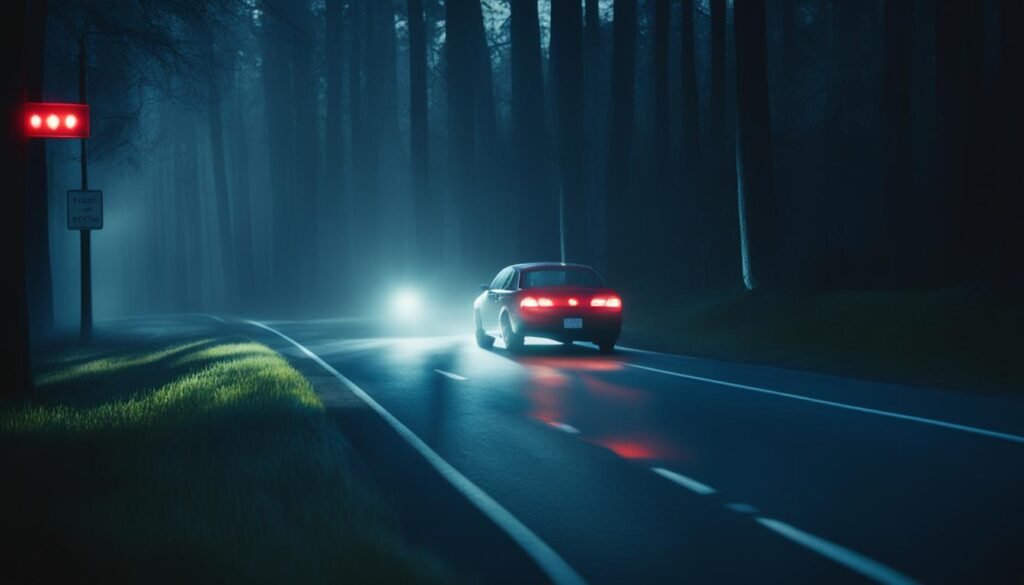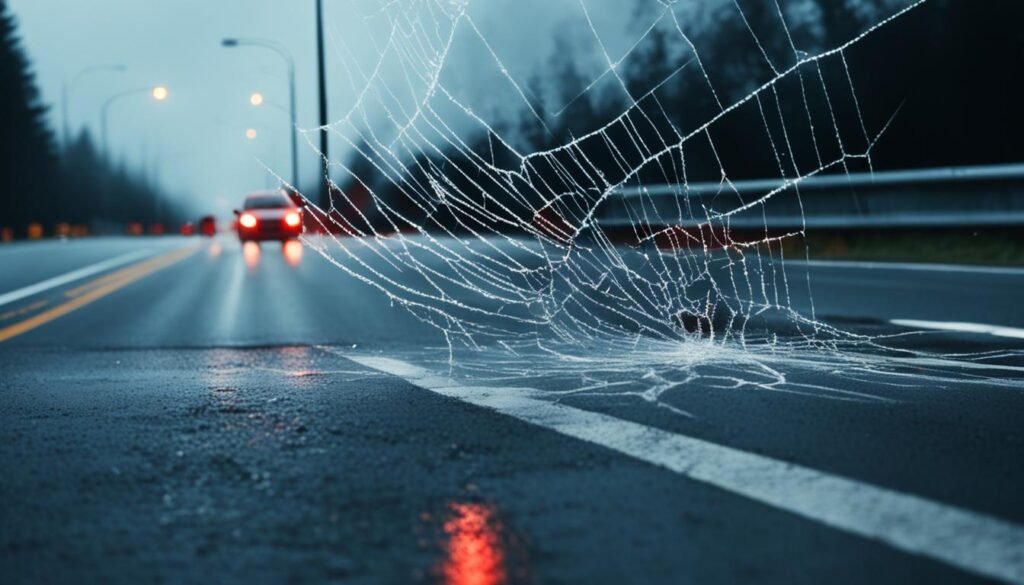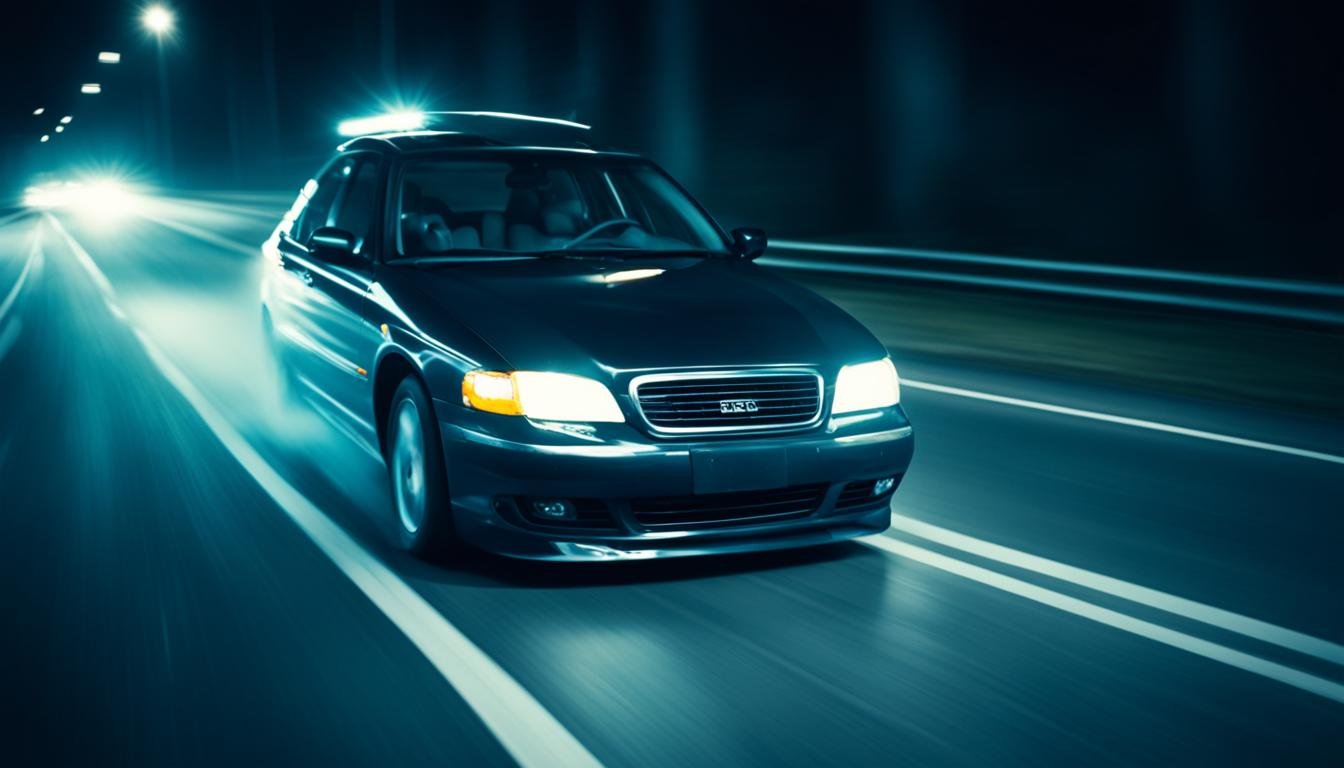Did you know half of all traffic deaths happen at night, although the roads are less busy? The National Safety Council reports that night driving is much riskier than daytime driving. This is because at night, it’s harder to see, judge distances, and react quickly.
Moreover, nighttime is more dangerous due to the higher chance of meeting drunk or sleepy drivers. To stay safe, it’s vital to be more careful of other drivers. Remember to keep your windshield and mirrors clean, check your lights, keep a safe distance from other cars, avoid looking directly at oncoming lights, don’t drive if you’re tired, keep inside lights low, watch out for animals, and lessen distractions to deal with the dangers of drunk driving effectively.
Key Takeaways:
- Driving at night accounts for half of all traffic-related deaths, despite fewer vehicles on the road.
- Limited visibility, impaired depth perception, and reduced reaction time make driving at night more dangerous.
- The risk of encountering drunk drivers is higher at night.
- By following safety tips and being vigilant, you can navigate the dangers of drunk driving at night.
- Super Attorneys of Irvine can help you with legal issues related to drunk driving.
The Dangers of Driving at Night
Driving at night is much more dangerous than driving during the day. At night, it’s harder to see and identify risks like drunk or tired drivers. Also, the glare from other cars’ headlights can blind you for a moment.
To understand night driving dangers, know that there’s less light. This makes it tough to see and judge distance. Bad weather can make this even worse, raising accident risks.
When driving at night, you might run into drunk drivers more often. The NHTSA says many deadly night crashes involve alcohol. Drunk drivers react slowly and make poor decisions, posing a big threat.
“Driving at night can be dangerous because there’s less visibility and more drunk drivers. Being cautious and practicing safe driving can lower night driving risks.”
Tired drivers also make night driving risky. Being sleepy hurts a driver’s focus, speed in reacting to danger, and decision-making. This, mixed with low visibility, makes accidents more likely.
Headlights from other cars can also cause problems at night. They can dazzle you, making it hard to see. Don’t look straight at oncoming lights and adjust your mirrors to avoid glare.
To stay safe at night, take these extra steps:
- Keep your windshield and mirrors clean for optimal visibility.
- Inspect and test your lights regularly to ensure they are functioning correctly.
- Increase your follow distance to allow for additional reaction time.
- Avoid staring into oncoming lights to prevent temporary blindness.
- Avoid driving when drowsy and take breaks when necessary.
- Dim your cabin lights to minimize distractions and maintain night vision.
- Be cautious of wildlife, as they tend to be more active at night.
By following these tips, you can reduce risks and make your night journey safer.
Safety Tips for Driving at Night
Driving at night needs more care to keep you and others safe on the road. Here are some tips to lower the risks:
- Ensure proper vehicle maintenance: Check your lights and signals are working before you go. Keep your windshield and mirrors clean to see better.
- Use your headlights correctly: Turn on your lights at dusk or when it’s hard to see. Use low beams in the city and high beams when alone on the road.
- Reduce distractions: Keep the noise down and avoid using your phone. It’s important to stay focused on driving.
- Maintain a safe distance: Keep a good space between you and the car ahead. This gives you more time to react if something happens.
- Be mindful of oncoming headlights: The bright lights from other cars can hurt your eyes. Don’t look right at them. Use the road’s edge to guide you.
- Stay awake and alert: Don’t drive if you’re sleepy. If you feel tired, stop at a safe spot and rest.
- Be cautious of wildlife: Animals are out more at night. Watch for them and slow down if you see any.
Keep these tips in mind for safer night driving. Being careful and ready can really help avoid accidents.

Additional Precautions for Night Driving
Following general safety tips for night driving is important, but you can do more. There are extra steps that can make your night driving safer. It minimizes the risks that come with it.
1. Check Your Tire Pressure and Tread
Keeping your tires in good shape is key for safe night driving. Make sure they are well-inflated and the tread is deep enough. Bad tire pressure can mess with how your car drives. Also, old tires might not grip the road well, raising accident risks.
2. Clean Your Headlights and Taillights
Being able to see clearly is crucial when you drive at night. Make it a habit to clean your headlights and taillights. Dirt and grime can make them less effective. If they’re dirty, it’s harder for you to see and for others to spot you.
3. Adjust Your Rearview Mirror
Headlight glare from cars behind you can make it hard to see. You can fix this by adjusting your rearview mirror to night mode. This reduces the glare in your eyes and helps you keep your focus on the road.
4. Use Anti-Glare Measures
If the glare from oncoming cars bothers you, try anti-glare tips. Wear polarized sunglasses or add an anti-glare visor to your car. These can cut down on the glare and help you see better.

5. Watch Out for Wildlife
At night, you’re more likely to run into animals on the road. Keep an eye out for wildlife that might cross your path. Slow down if needed and use your high beams wisely. This lights up the road without blinding other drivers.
To drive safely at night, take these extra precautions. Always be alert, drive carefully, and keep a safe distance from other cars. With proper prep and a cautious approach, night driving won’t be as risky.
Conclusion
Driving at night is harder and more dangerous than during the day. Limited visibility and the chance of running into drunk drivers make it tricky. It’s very important to be extra careful and follow safety tips.
To avoid the dangers of drunk driving, keep a sharp lookout for other drivers. Make sure your windows and mirrors are clean. Check your lights often and keep a safe distance from other cars. Don’t stare into oncoming lights and try to stay focused on the road.
If you’re caught up in legal issues from drunk driving, get help from Super Attorneys of Irvine. They’ll find you a great lawyer. This lawyer will guide you, defend your rights, and help you through the legal system. For more info, call 949-996-9546 or click businesslawyersirvine.com.

